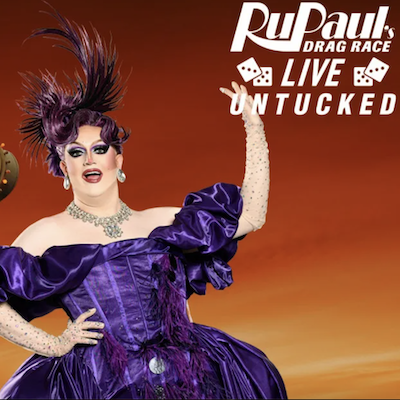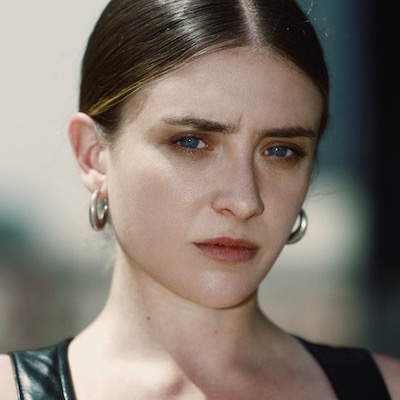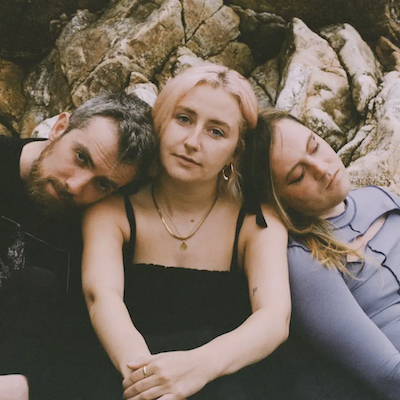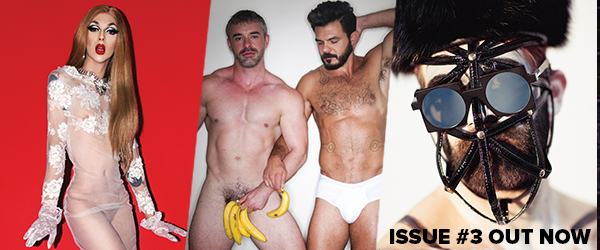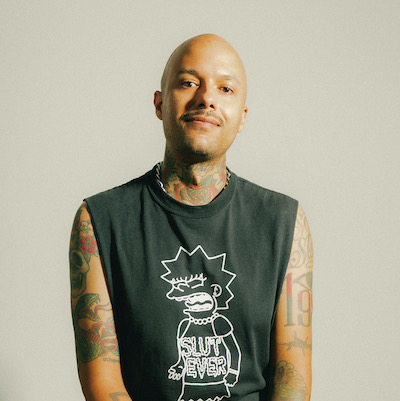
Zach Grear’s tattoo-covered portraits of queer icons and male-erotica on Instagram have intrigued us for years. Troubling the boundaries between what is beautiful and what is grotesque, we learned more about his relationship to his highly erotic images as he releases his second collection of work ‘Shower with Affection Group Shower this summer.
Hi Zach! I wanted to start off asking you about your entry into art, what provoked you to start to create?
I’ve been drawing since I was a kid and a lot of times I would draw women in fancy outfits. That’s kind where I started. As I got into video games, I started drawing characters from them and then started creating my own. That was the consistent theme throughout my youth. It was always just a hobby until maybe 2017 when I started pushing it a little bit more in terms of posting my art, especially creating queer art & gay erotic art and just zeroing in on that.
I think probably as with most queer people, there are still remnants of shame. And so, with the idea of drawing gay erotica, for some reason, there was a disconnect in terms of me exploring and really being open with that. So as soon as I started pushing, promoting, and posting, I got such a great reaction from my peers, from people I don’t know on Instagram, and it woke me up to like, ‘Oh, this art brings me joy and I like creating it, so let me continue to do that.’ That’s the jumping off point and what started me to where I am now.
So, Instagram was in some way, like a forum for you to start sharing your work?
That was the catalyst. Through that, I started meeting other queer artists and was able to take it offline, meet people, learn about events, vending, just art shows and things like that. So, I do have to credit Instagram and social media with being able to put me in contact with a lot of amazing queer artists.

Online communities can be helpful when you’re creating your own work in a community where you don’t feel acceptance, or that there’s a space for that kind of work, or that it could affect your career or social associations. What was the catalyst to switch from drawing glamorous women to these homoerotic images?
Well, that’s a good question. I think there are multiple layers. My style of doing a lot of tattoo imagery, really began as I got more and more tattooed. It became a standard of beauty and something that I pursued. It’s something I wanted to include in my art. If I’m drawing hot guys, it became necessary then to add the tattoos because that was a part of how I see a beauty standard in the world – heavily tattooed people, even unrealistically tattooed people. That is how that started. Then using found imagery and vintage erotica took it to the next level as well.
I think I’ll always have that part of me that loves drawing women or any gender identity or non-binary, however, I really am focused on that gay lens, that gay erotic lens, just because it brings me joy and I feel such a connection with it and want to keep pursuing it.
Well, it seems like, in my own opinion, when you present these women like Grace Jones, Siouxsie Sioux, or other real life queer icons that you’re commenting on that. The way that you use the tattoos is different in terms of the semiotics than those of the erotic men. Do you have a different approach when you use queer icons as a subject?
Definitely. Along with the gay erotic art, I usually like to focus on queer heroes of mine, people I admire or even just people in my local community. So, with Grace Jones, Siouxsie Sioux, Audre Lorde and James Baldwin, I view drawing them as my way of honoring them. I like to look up facts about them: the year they were born, career hallmarks, their songs, zodiac sign and incorporate them into the art as a way of building a tribute to them in my own way. And with the gay erotica, the different poses make it a lot more fun to figure out where I can clip certain tattoos. However, both usually have their own flow that I don’t feel until I’m sitting, looking at the drawing I’m going to do.
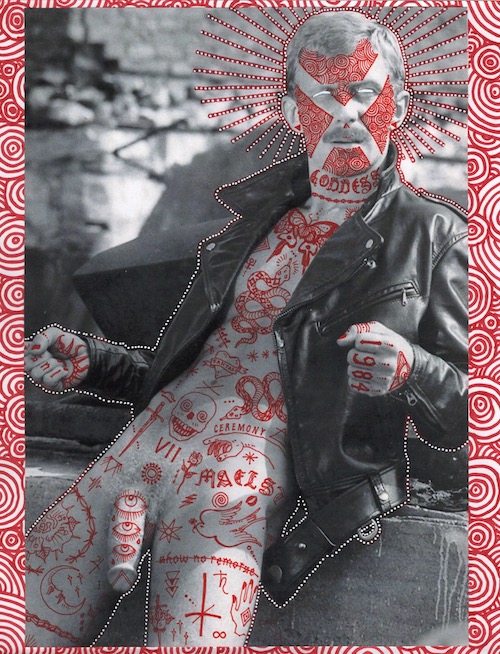
With the male erotica specifically, you’re choosing obviously because of its medium, photography from the 20th century. What is your personal relationship to these sorts of images? Do you think what is idealized in gay culture has changed, even in the past 10 or 15 years in terms of standards of beauty? As an outside eye, it seems you choose these images to then tag your 21st century voice on top of these images.
Yeah, I think, you’re exactly right. I do like the tension of a Bob Mizer 1960s muscle mag guy meeting my very “now” interpretation and drawings and symbols onto it. Taking something that’s already nearly 60 years old, to another place now that’s my own standard. I do like the jarring nature of that. I mean honestly, if we’re talking about the evolution of gay male erotica and beauty standards, how much have they really evolved? If you look at the covers of Honcho throughout the decades like 70s to 2009, I think when it folded, it’s going be a hot white guy. I’m trying to explore other erotica, like On Our Backs, a really famous lesbian erotica magazine, and honestly, just looking at three different covers of it, you see different body types, different races, interracial couples and that’s just on three different random covers that I looked up.
So, knowing that I must be aware of that, be aware of the images I’m choosing and make sure I’m not falling into a hole of just idealizing white beauty standards. That’s just how it goes, and some days are better than others. I try to catch myself if I’m drawing non-stop white guys and making sure that I’m pulling out a little bit and looking at a wider range. And I still have a long way to go with that, but if I want to work in vintage gay erotica, that is kind of the playing field that I’m in.
I know personally, when you sort of have these images or ideals that are somehow separate from the present day, it’s easier to idolize them. They become whatever you want them to be. Just like maybe it’s hard for me, as a musician, to relate to a musician that’s my age in the same way that I would someone that’s 20 years older than me because they aren’t mysterious to me. Maybe there’s an element that vintage gay culture can be fetishized because we have distance from it?
Yeah, totally. I think that is a big part of why, like the vintage era or like 50s through to 90s is what I gravitate towards the most because it is a time capsule and just seeing the creativity that had to be involved on a budget. Porn is obviously a big business right now, but back then, gay porn was especially low budget. What kind of access did they have to funding, or were they really just like, ‘The sun is about to set in 10 minutes, we need to get the shot. Let’s figure it out.’ So, there’s a lot of creativity there. Honestly, it can seem a lot more fun, a lot cheesier, just corny, but it pulls me in and I like to keep that era and that scene alive in my own way. I guess you could say it’s a way of me trying to make a tribute to it the same way that I want to make a tribute to my queer icons like Grace Jones and Audre Lorde.
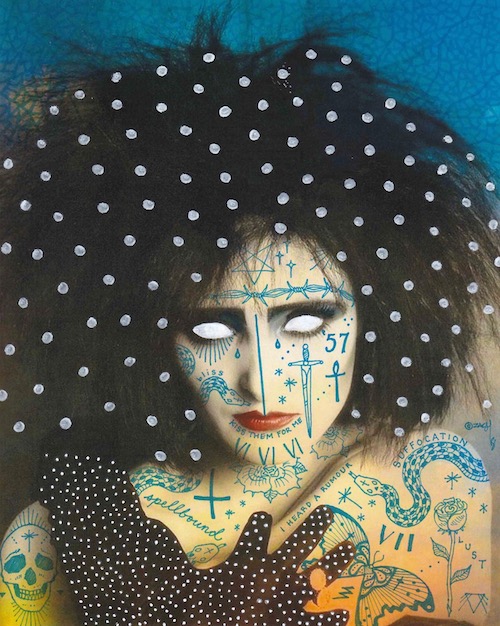
You mentioned the Lesbian Punk influenced Magazine “On Our Backs”. As a professor that teaches a course on Punk, a lot of your work reminds me of some zines, in some ways, of images from the Queercore and Riot Grrl movements. You seem to have an ethos of taking imagery and doing graffiti on the imagery or presenting your own viewpoint on something that’s being mass-produced.
Yeah, I appreciate that. I really enjoy learning about Queercore, zines especially, and that handmade aspect to it I really admire. I print a lot of images I do, and then I hand-draw on them. I’ve gotten into some digital art, but for the most part I like the analog aspect to it. And I admire the zine, and I do think queer is punk, so thank you, I’m glad to have a relationship to that.
You did a recent Tom of Finland collaboration and published a collection of your work called Shower with Affection. What else can we look forward to?
Yes! We are anticipating volume two of Shower with Affection: Group Shower. In 2020, I released the first volume, which was a collection of drawings that I did based on Bob Mizer’s shower series. In October, I did an open call for all queer artists to submit their own work based on or inspired by the Bob Mizer shower series. We’re looking to get the pre-sale on soon, so stay tuned for that. But I’m excited. It’s the first time I’ve ever curated a collection of queer artists’ work, and I’ve gotten such a great response. It really buoys me and feels like it’s keeping me afloat in the community. Ideally, it should come out this month for Pride! Once it’s at the printer and all the little things are fixed, it’ll be out and pre-sale will be live. Hopefully we’ll have a launch party for it too.

And finally, we are named after the biggest-selling single of 2001, so we always ask, what is your favourite Mariah Carey song?
My favorite is ‘Breakdown, from the Butterfly album. I just think the story is so well-said. This idea of different expectations of a relationship, being very into somebody, wanting to still seem nonchalant about it when they aren’t as into the relationship and you’re breaking down because you’re not being honest with yourself or with them, but you still want their approval, and so you’re going with it.
Yeah, the narrator is kind of a flawed person in some ways, which is vulnerable for her to present herself that way.
Totally. It’s such a good inner dialogue. The lyrics are literally going over in your head that you know better, but you’re not acting on it and just that cycle. I just think it’s excellent and still potent to this day.
Shower With Affection: Group Shower is out now
All artwork by Zach Grear. Main photo by Travis Chantar
www.zachgrear.com
Interview by George Alley



